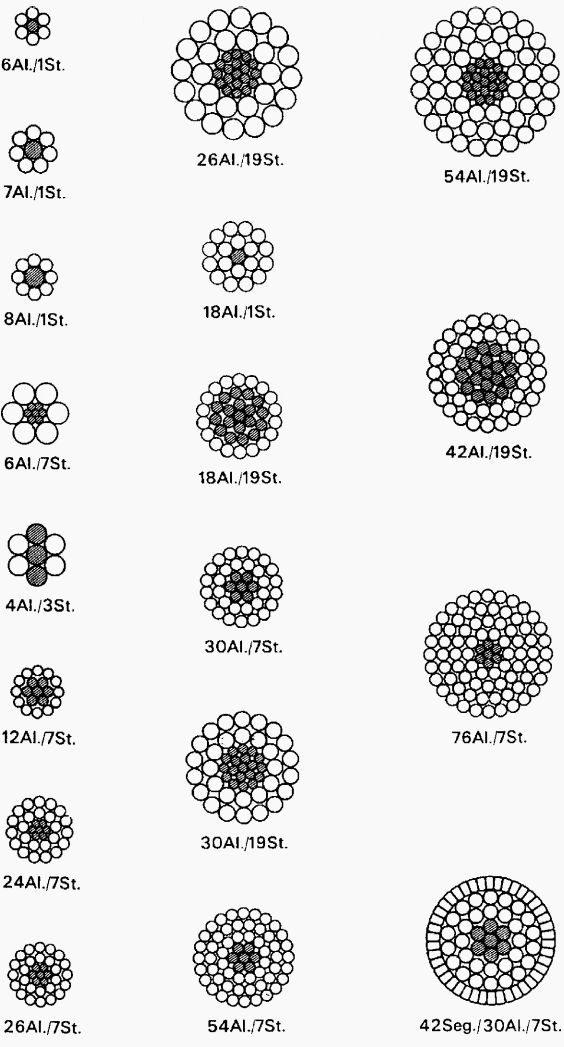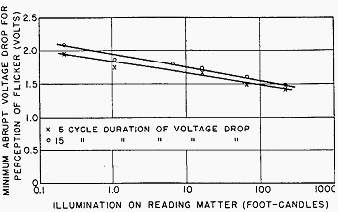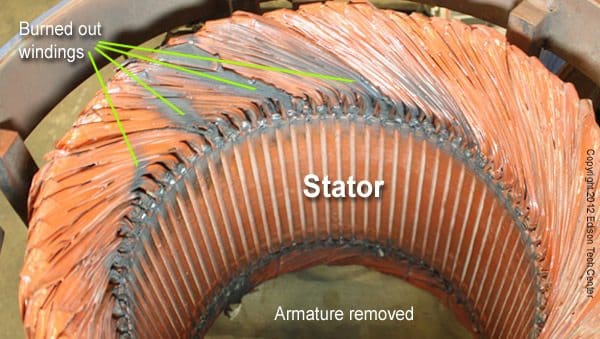| ||
Aluminium and its alloys conductor steel reinforced
The international standards covering most conductor types for overhead lines are IEC 61089 (which supersedes IEC 207, 208, 209 and 210) and EN 50182 and 50183 (see Table 1).
For 36 kV transmission and above both aluminium conductor steel reinforced (ACSR) and allaluminium alloy conductor (AAAC) may be considered. Aluminium conductor alloy reinforced (ACAR) and all aluminium alloy conductors steel reinforced (AACSR) are less common than AAAC and all such conductors may be more expensive than ACSR.
Relevant national and international standards
| Standard | Title | Comment |
| IEC 61089 | Round wire concentric lay overhead electrical stranded conductors | Supersedes IEC 207 (AAC), 208 (AAAC), 209 (ACSR) and 210 (AACSR) |
| EN 50182 | Conductor for overhead lines: round wire concentric lay stranded conductor | Supersedes IEC 61089 for European use. BSEN 50182 identical |
| EN 50183 | Conductor for overhead lines: aluminium–magnesium–silicon alloy wires | |
| BS 183 | Specification for general purpose galvanized steel wire strand | For earth wire |
| BS 7884 | Specification for copper and copper–cadmium conductors for overhead systems |
Historically ACSR has been widely used because of its mechanical strength, the widespread manufacturing capacity and cost effectiveness.
For all but local distribution, copper-based overhead lines are more costly because of the copper conductor material costs. Copper (BS 7884 applies) has a very high corrosion resistance and is able to withstand desert conditions under sand blasting.
All aluminium conductors (AAC) are also employed at local distribution voltage levels.
From a materials point of view the choice between ACSR and AAAC is not so obvious and at larger conductor sizes the AAAC option becomes more attractive. AAAC can achieve significant strength/weight ratios and for some constructions gives smaller sag and/or lower tower heights. With regard to long-term creep or relaxation, ACSR with its steel core is considerably less likely to be affected.
Jointing does not impose insurmountable difficulties for either ACSR or AAAC types of conductor as long as normal conductor cleaning and general preparation are observed. AAAC is slightly easier to joint than ACSR.
Figure 1 illustrates typical strandings of ACSR. The conductor, with an outer layer of segmented strands, has a smooth surface and a slightly reduced diameter for the same electrical area.

Figure 1 - Conductor arrangements for different CSR combinations
Historically there has been no standard nomenclature for overhead line conductors, although in some parts of the world code names have been used based on animal (ACSR – UK), bird (ACSR – North America), insect (AAAC – UK) or flower (AAAC – North America) names to represent certain conductor types.
Aluminium-based conductors have been referred to by their nominal aluminium area. Thus, ACSR with 54 Al strands surrounding seven steel strands, all strands of diameter d 3.18 mm, was designated 54/7/3.18; alu area 428.9 mm2, steel area 55.6 mm2 and described as having a nominal aluminium area of 400 mm2.
In France, the conductor total area of 485 mm2 is quoted and in Germany the aluminium and steel areas,429/56, are quoted. In Canada and USA, the area is quoted in circular mils (1000 circular mils 0.507 mm2).
Within Europe standard EN50182 has coordinated these codes while permitting each country to retain the actual different conductor types via the National Normative Aspects (NNAs).
Table below explains the EN 50182 designation system.
Conductor designation system to EN50182:2001
- A designation system is used to identify stranded conductors made of aluminium with or without steel wires.
- Homogeneous aluminium conductors are designated ALx, where x identifies the type of aluminium. Homogeneous aluminium-clad steel conductors are designated yzSA where y represents the type of steel (Grade A or B, applicable to class 20SA only), and z represents the class of aluminium cladding (20, 21, 30 or 40).
- Composite aluminium/zinc coated steel conductors are designated ALxISTyz, where ALx identifies the external aluminium wires (envelope), and STyz identifies the steel core. In the designation of zinc coated steel wires, y represents the type of steel (Grades 1 to 6) and z represents the class of zinc coating (A to E).
- Composite aluminium/aluminium-clad steel conductors are designated ALxIyzSA, where ALx identifies the external aluminium wires (envelope), and yzSA identifies the steel core as in 2.
- Conductors are identified as follows:
- A code number giving the nominal area, rounded to an integer, of the aluminium or steel as appropriate;
- A designation identifying the type of wires constituting the conductor. For composite conductors the first description applies to the envelope and the second to the core.
The development of ‘Gap type’ heat-resistant conductors offers the possibility of higher conductor temperatures.
The design involves an extra high strength galvanized steel core, and heat-resistant aluminium alloy outer layers, separated by a gap filled with heat-resistant grease. To maintain the gap, the wires of the inner layer of the aluminium alloy are trapezoid shaped. Depending on the alloys used, temperatures of up to 210°C are possible, with a current carrying capacity of up to twice that of hard-drawn aluminium.
This offers particular value where projects involve upgrading existing circuits.







